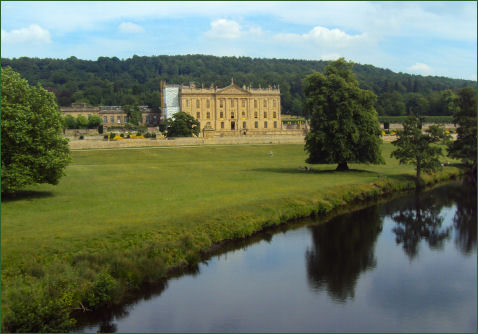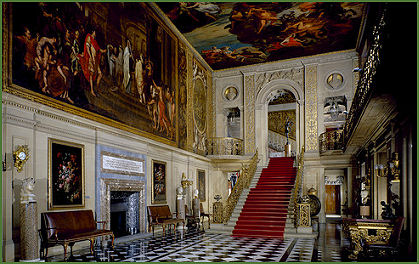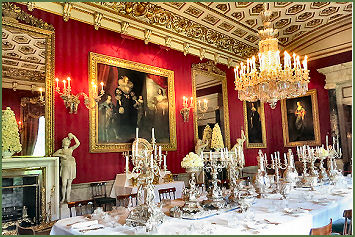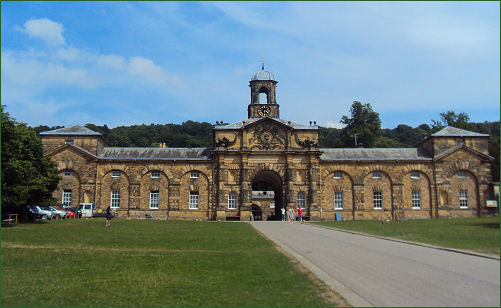Chatsworth House
Grid Ref: - SK463637
 Magnificent Chatsworth House, known as "The Palace of the Peak" is the country seat of the Dukes of Devonshire and is situated on the banks of the River Derwent, 3.5 miles to the northeast of Bakewell in the heart of the Peak District National Park.
Magnificent Chatsworth House, known as "The Palace of the Peak" is the country seat of the Dukes of Devonshire and is situated on the banks of the River Derwent, 3.5 miles to the northeast of Bakewell in the heart of the Peak District National Park.
The first house to occupy the site was constructed in the mid sixteenth century by Sir William Cavendish (1505-57) and his third wife, the formidable Bess of Hardwick (c. 1527-1608), who rose from obscure origins to become one of the wealthiest women in Elizabethan England.
Another William Cavendish was created Earl of Devonshire in 1618 and his great-great-grand-son, William Cavendish, fourth Earl of Devonshire was created the first Duke of Devonshire in 1694 for his role in helping to bring the joint monarchs William of Orange & Mary II to the English throne.
The first Duke made major changes to the original Elizabethan house between 1686 and 1707. He completely rebuilt the south front, adding the magnificent State Apartments, before rebuilding the east front including the Painted Hall and Long Gallery. The Duke then built the new west front between 1699 and 1702 to his own design, and finally the north wing with its bowed front, to create the masterpiece seen today. He also added formal gardens and the famous cascade. The 1st Duke's Chatsworth was a key building in the development of English Baroque architecture.
The sixth Duke, referred to as 'the Bachelor Duke', added the Library and the North Wing between 1790 and 1858, he engaged the services of Jeffry Wyatville, the architect who was employed by King George IV to work on Windsor Castle. The picturesque bridges over the River Derwent were constructed in the eighteenth century. The park was landscaped by the 4th Duke (1720-1764), who employed 'Capability' Brown to design the striking landscape which the visitor to Chatsworth sees today. He altered the course of the River Derwent, carried out extensive tree planting and swept away the old formal gardens.
 Chatsworth's Great Staircase sweeps down to the Painted Hall, one of the most stunning rooms in the house, its floor that was laid by the 6th Duke in 1834, the room is adorned with scenes from the life of Julius Caesar by Luigi Laguerre (1663-1721). Black and white marble floors and gilt ironwork make it truly spectacular.
Many of the figures in the painted ceilings and cornices appear to be three-dimensional, an illusion made by the clever use of shadows.
Chatsworth's Great Staircase sweeps down to the Painted Hall, one of the most stunning rooms in the house, its floor that was laid by the 6th Duke in 1834, the room is adorned with scenes from the life of Julius Caesar by Luigi Laguerre (1663-1721). Black and white marble floors and gilt ironwork make it truly spectacular.
Many of the figures in the painted ceilings and cornices appear to be three-dimensional, an illusion made by the clever use of shadows.
The so called Scots Rooms, in the east wing, one of which boasts handpainted Chinese wallpaper, make up the section of the house which was used to house Mary Queen of Scots, who was placed in the custody of the 6th Earl of Shrewsbury by Queen Elizabeth I at various times between 1569 and 1584. Talman rebuilt the rooms for the 1st Duke of Devonshire between 1693 and 1695 and the whole floor was transformed again by Wyatville in around 1830 when the Chinese wallpapers were hung. The Leicester Rooms also date from that period and recall the visit of Robert Dudley, 1st Earl of Leicester to Chatsworth in 1577. The Wellington Dressing Room and Bedroom are named after the Duke of Wellington who stayed at Chatsworth in the winter of 1843 on the occasion of the visit of Queen Victoria.
The showpiece Great Dining Room (below left), with its painted ceiling, gilt tables and family portraits, has its table set as it was for the visit of George V and Queen Mary in 1933. On the walls hang seven Van Dyck paintings, the light fixtures on the walls come from Devonshire House . The State Drawing Room has painted walls and ceilings, antique furniture and exquisite tapestries, including a priceless tapestry based on Raphael's cartoons, which dates back to 1635.
 The State Music Room has a painted violin hanging on the door which is the work of Jan van der Vaardt (c. 1653-1727), the room houses a green table of Russian malachite which was received as a gift from Tsar Nicholas I of Russia and the coronation throne of King George III.
The State Music Room has a painted violin hanging on the door which is the work of Jan van der Vaardt (c. 1653-1727), the room houses a green table of Russian malachite which was received as a gift from Tsar Nicholas I of Russia and the coronation throne of King George III.
 The magnificent State Bedroom houses a crimson and gold bed which was made in 1723 and once belonged to King George II. King George V and Queen Mary slept in this bedroom when they stayed at Chatsworth in 1933. The walls are covered in a stamped and gilded leather ordered by the 6th Duke in 1830 and the ceiling is by Laguerre.
The magnificent State Bedroom houses a crimson and gold bed which was made in 1723 and once belonged to King George II. King George V and Queen Mary slept in this bedroom when they stayed at Chatsworth in 1933. The walls are covered in a stamped and gilded leather ordered by the 6th Duke in 1830 and the ceiling is by Laguerre.
The Library at Chatsworth (pictured left) is one of the most beautiful rooms in the House, and holds one of the largest and most significant collections of books still in private hands, as well as prints and Old Master drawings, there are over 17,000 volumes in the room and in the Ante-Library, and now more than 50,000 in the whole collection. The gallery and bookcases were designed by Wyatville.
The superb chapel at Chatsworth (pictured right) was constructed between 1688 and 1693 by the 1st Duke, and has remained unaltered ever since. Laguerre and Ricard painted the walls and ceilings with scenes from the life of Christ and the picture of Doubting Thomas over the altar is the work of Verrio. Rembrandt's Portrait of an Old Man hangs in the room.
Throughout Chatsworth house there are paintings, tapestries and fine pieces of furniture. The sculpture gallery, which houses the sixth Duke of Devonshire's collection, contains magnificent specimens from Classical times, to the present. Modern work is also well represented with sculptures by Angela Conner and Elizabeth Frink and paintings by Lucian Freud.
 Chatsworth boasts one of Europe's most significant art collections, including works by Gainsborough, Landseer, Rembrandt, Renoir, Sargent, Tintoretto, Van Dyck, Veronese and Zoffany. The Sketch Galleries contain some of the many family portraits. The diverse collection is continually added to, encompassing Old Masters to contemporary ceramics and artefacts from Ancient Egypt, through to cutting edge modern sculpture and computer portraits.
Chatsworth boasts one of Europe's most significant art collections, including works by Gainsborough, Landseer, Rembrandt, Renoir, Sargent, Tintoretto, Van Dyck, Veronese and Zoffany. The Sketch Galleries contain some of the many family portraits. The diverse collection is continually added to, encompassing Old Masters to contemporary ceramics and artefacts from Ancient Egypt, through to cutting edge modern sculpture and computer portraits.
The mainly nineteenth century gardens include the 300 year old Cascade, the trough waterfall in the rockery and the enormous gravity-fed Emperor fountain. There are numerous, lakes, pools, cascades and fountains making Chatsworth perhaps the ultimate water garden of England. Queen Mary's Bower, a type of summer house near the bridge is the only part of the gardens to survive from the sixteenth century. encloses an ancient earthwork and was frquented by Mary, Queen of Scots when she was a prisoner at Chatsworth.
 In the nineeteenth century, Sir Joseph Paxton (of Crystal Palace fame) and the sixth Duke of Devonshire created a classic mixed style garden adjoining the house.
In the nineeteenth century, Sir Joseph Paxton (of Crystal Palace fame) and the sixth Duke of Devonshire created a classic mixed style garden adjoining the house.
New parterre gardens were made next to the house in the nineteenth century. As well as the huge maze, the rockery and the rose, cottage and kitchen gardens, there are also over five miles of walks with rare trees, shrubs, streams and ponds to discover.
Chatsworth House lies in the centre of a superb 1,000 acre parkland in the Derwent Valley, encircled by a deer fence 9 miles long. The Hunting Tower which stands on the wooded hill to the east of the house dates back to the 1580's and was frequented regularly by Bess of Hardwick and Mary Queen of Scots. There is also a state-of-the art Adventure Playground in the woods.
Admission to the park is free, and in common with the Chatsworth Farm Shop and its restaurant, is open all the year round.
The Cavendish family, Dukes of Devonshire
Georgiana, Duchess of Devonshire
